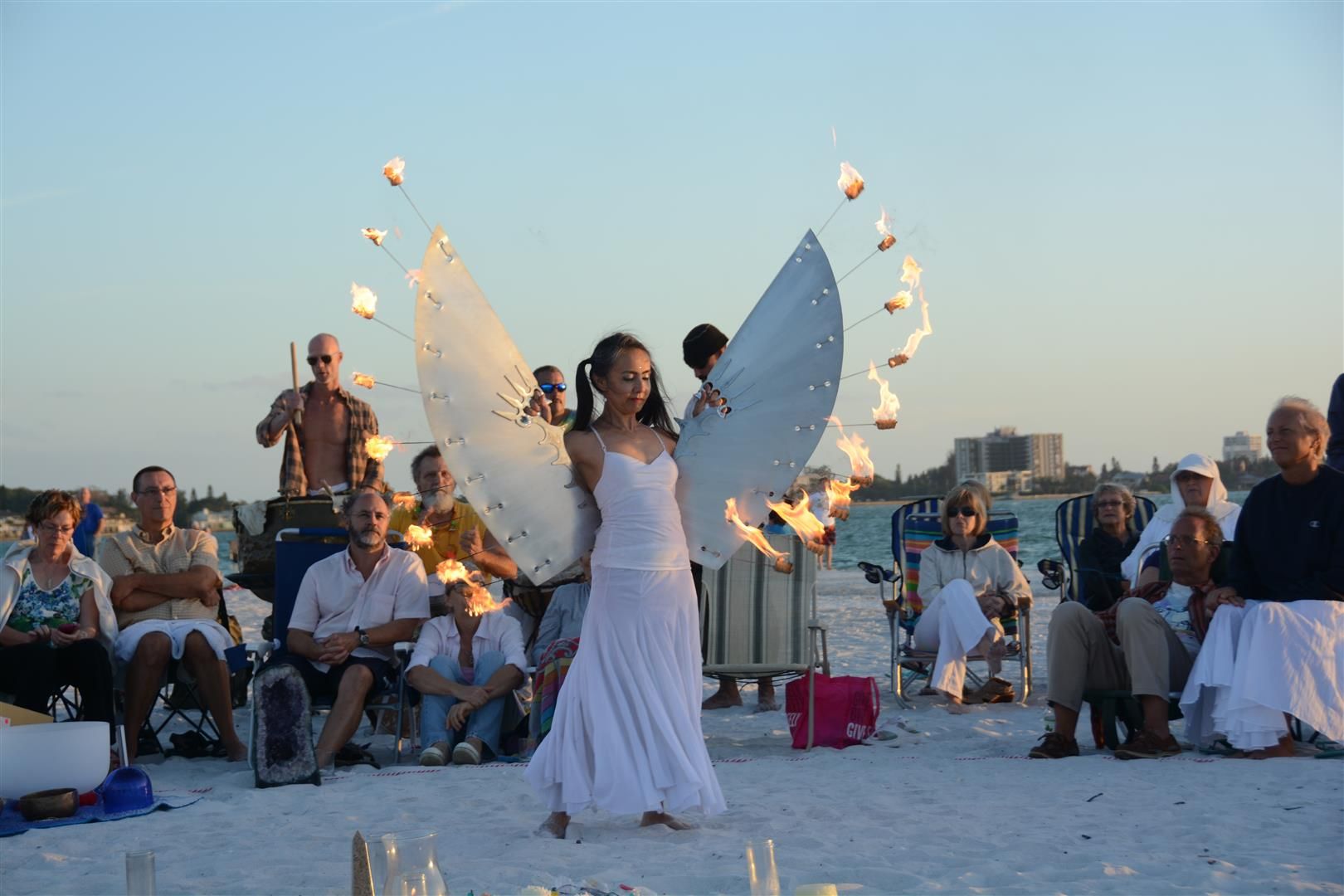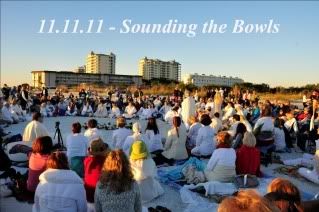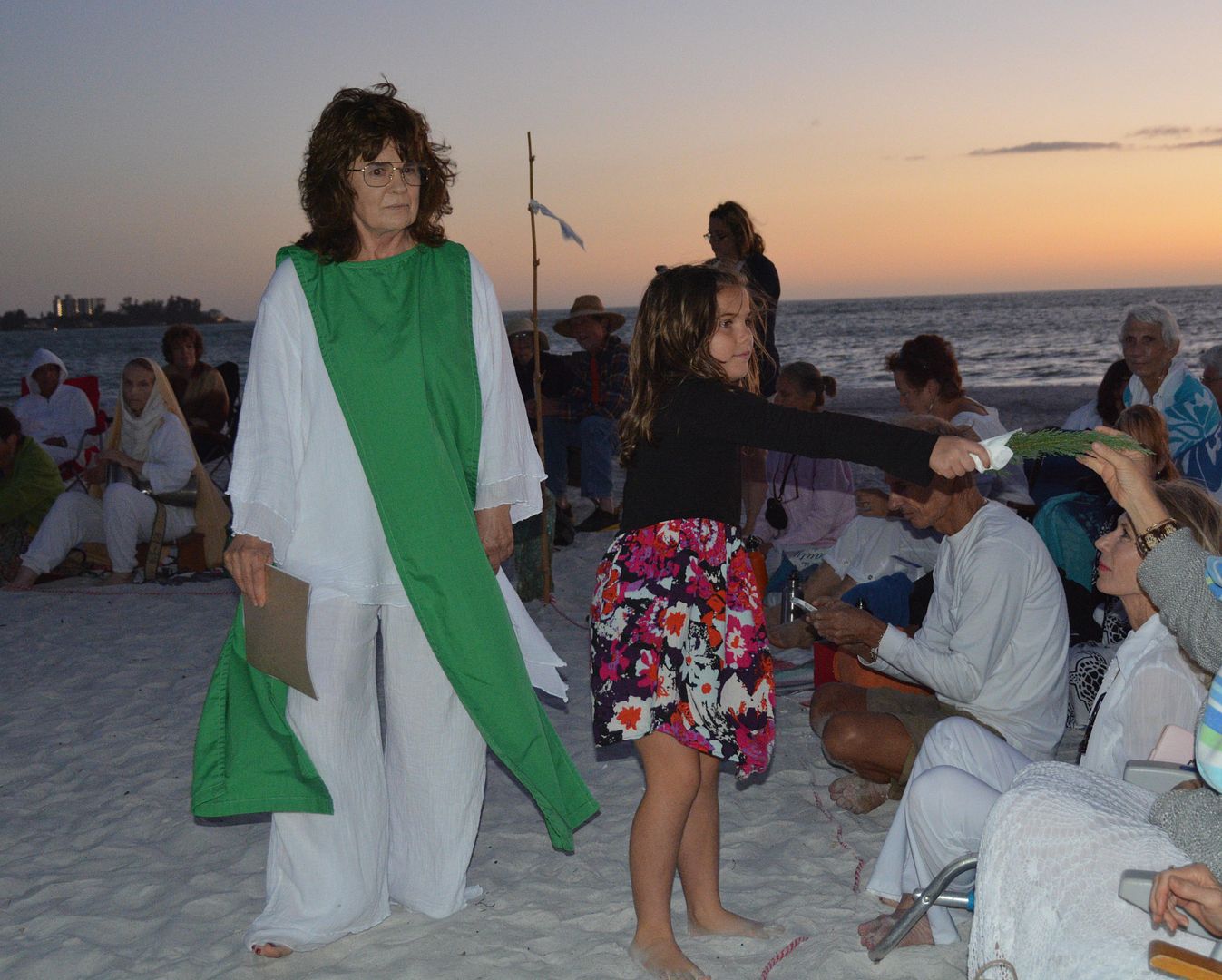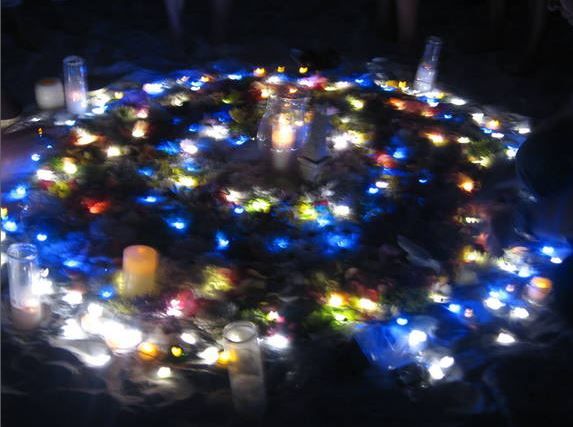Why Ceremonies?
Torches
at the four directions glow in the fading light of day. The scent of
incense fills the air. A drum beats an ancient rhythm as the notes of a
flute entwine with  the drumbeat. As the celebrant approaches the eastern directional gate,
a hush falls over the assembly. Candles on the altar in the center of
the circle are lit one by one. An invocation accompanies the lighting
of each. With the sacredness of the ceremony set, the story of the
event is choreographed to dance and
the drumbeat. As the celebrant approaches the eastern directional gate,
a hush falls over the assembly. Candles on the altar in the center of
the circle are lit one by one. An invocation accompanies the lighting
of each. With the sacredness of the ceremony set, the story of the
event is choreographed to dance and music. This is ceremony!
Humans have celebrated with like rituals and ceremonies for over one hundred thousand years. Archaeologists found pottery, tools, and cave paintings indicating they were an essential component in the lives of every ancient culture. Societies recognized the seasons of planting and harvest, the movement of the moon and stars, and honored birth and death. At some point, religion crept into the ceremonies complicating or altering many of the ancient practices. Yet the dates marking the seasons were kept with attributions to the different Gods of each religion.
For the past twelve years ceremonies have been an integral part of the practices in our community. Individuals with similar beliefs mark the dates by participating in or
 supporting the vision inherent in each gathering. The past decade
offered up a rare occurrence that happens only once each century.
Between 2001 and 2012 the calendar dates 01-01-01 through 12-12-12 were
identified as cosmic trigger events and celebrated as such. On each of
the triple numerical dates, a special ceremony, tied to the numerology
of the date, was held. It ended with a large gathering on 12.12.12 known
as Sounding the Bowls where hundreds of crystal and Tibetan bowls were
sounded in concert across the waters of the Gulf of Mexico.
supporting the vision inherent in each gathering. The past decade
offered up a rare occurrence that happens only once each century.
Between 2001 and 2012 the calendar dates 01-01-01 through 12-12-12 were
identified as cosmic trigger events and celebrated as such. On each of
the triple numerical dates, a special ceremony, tied to the numerology
of the date, was held. It ended with a large gathering on 12.12.12 known
as Sounding the Bowls where hundreds of crystal and Tibetan bowls were
sounded in concert across the waters of the Gulf of Mexico. But what about ceremonies? What are they and what do they do for the human psyche? And why should we in the modern world do ceremonies or rituals? There's an easy answer. Rituals and ceremonies connect us to an ancestry and history that provide a glimpse into a time and heritage long past. When performed in the modern era, they remind us to halt the noise of everyday life and to remember the meaning of sacred space and the power of seasonal changes. Even more, they acknowledge the spiritual mystery inherent in celebrating special events, stimulating reverent qualities in all attendees.

It's easy to identify with Equinoxes and Solstices which represent Spring, Summer, Autumn, and Winter. But if you've been part of these gatherings, you know each season or ceremony carries its own frequency that changes from year to year, though the event is the same.
Each celebrant brings practices that makes each ceremony unique. For example, a Celtic Bard might enact a story of the Return of the Light on the Winter Solstice that includes the use of hundreds of candles. A shamanic practitioner might instead use the power of imagination to journey into the darkness to find the light and return it to earth.
When children participate a benign sweetness descends on the gathering. There's recognition by all assembled that the next generation is being introduced to sacred patterns of harmony and reverence. And in their own way, the children respond. Shy ones find their voices, enter the circle, and speak to their elders with wisdom and clarity. The more outgoing children take leadership roles in the ceremony, writing prayers, poems, or wishes for peace on earth.
The size of a gathering can affect the energy either positively or negatively. But if
 the gathering is set in a containment field, like a circle, it's much
easier to feel sacred rhythms. An altar at the center of the circle
makes a statement to all attending that this is a holy gathering.
the gathering is set in a containment field, like a circle, it's much
easier to feel sacred rhythms. An altar at the center of the circle
makes a statement to all attending that this is a holy gathering. The role of officiant is important and carefully orchestrated. With exceptional power, they hold the containment field intact while voicing the intentions and impressions needed to make the ceremony solemn and reverent. When the intentions are set, the candles lit, incense is burning, drums are sounding, and dancers weaving around the altar in the center, the audience responds with awe for they have become entwined with the ceremony.
From these many gatherings, people connect, a community is built, grace flows, and blessings are bestowed for family, friends, and all beings on the planet. That is the sacredness of ceremony which really answers the question, Why Ceremonies.
Jo Mooy - December 2015
All Journals are archived on the website: Starsoundings Journals

No comments:
Post a Comment